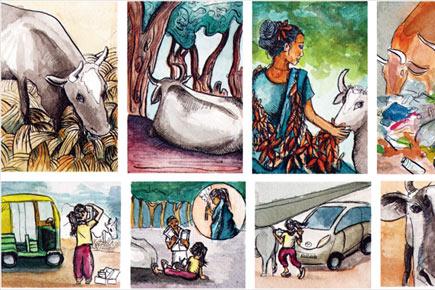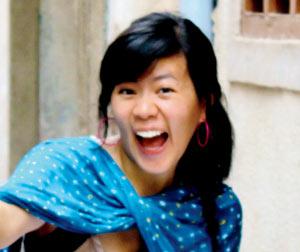One day, Rebecca Hui began stalking a cow. The day after, she followed another. In her exhibition, the Fulbright Scholar reveals the city’s urban issues through human-animal relationships, finds Kareena Gianani

Q. How did you get interested in exploring and mapping cities by studying human-animal interaction?
A. When I was 19, I decided to travel alone to a place very different than I know, and ended up in Gujarat. Perhaps the most notable new experience was the absence of meat in my food — instead they were frolicking on the streets. Cows went as they were pleased. They could sleep in the middle of an intersection and traffic would go around. Cows walked alongside the human, and one does not simply eat another. That was huge.
ADVERTISEMENT

Fulbright scholar Rebecca Hui’s illustrations depicting the cow-human interaction in cities
So, I thought to myself: If cows and humans have similar rights, what would it like to be a cow citizen in a human city? For three hours in a given day, I followed the first cow I saw. I would end up in gullies. I would end up in residential corners where I would sit on a patio for hours and people would offer a seemingly confused-Chinese American girl chai.
My experiences changed depending on whether a place was rural, traditional, or urban. The place would also determine friendly or hostile interactions between cows and humans.
There lies an intimate connection between the cow and the city. One can start to see how the city is changing based on these animals’ experiences.
Q. What significant inferences did you gather on urbanisation in Mumbai?
A. In Mumbai, which I consider the apex of urbanisation in India:
Cows
Their freedom to move is lost. The few places I’ve seen cows are at Aarey Milk Colony, Tardeo, or in Jain-populated areas. Even there, cows are generally tied down near grass for passers-by to pay and pray to. Cows have to be making money in order to retain space in the city. The cow is seen as a religious icon, but its relationship with humans is much more transactional.
Dogs
I observed how most people who build relationships with street dogs do so based on income, their vocation, and how much exposure to the street. For example, most of the caretakers I’ve observed are chaiwaalas, personnel at train stations, chaatwaalas, office helpers, and sympathetic aunties. Most caretakers belong to the lower income working class.
To explain this relationship, I have been told, “the poor and the stray share the same struggle to survive in the city.”
As far as vaccinations and neuterings are concerned, I feel there India is more tolerant and open to discussion about street dogs than the US, for instance.
Leopards
When it comes to studying city-animal interactions, the leopard is hardly the conflict; instead, the leopard is just a door to unveil the complexities of urban governance and socio-politics in the region. I often found that inert bureaucracy, land corruption interests, and fragmented management, were barriers to holistic and effective planning
and solutions.
Many tribes here have lived amongst wildlife for generations and believe that leopards are a vital part of the ecosystem. They often cite seeing leopards around their home nearly on a daily basis. Incidences of attacks on tribals are also less than from urban dwellers. I believe inherent in that statistic is a difference in mentality and lifestyles, a solution that should be further expanded.

Rebecca Hui, Fulbright Scholar in India
Q. Tell us about your children’s book.
A. Environmental concern generally circulates within academic circles. To get the broader public to become interested (especially the younger generation), I wanted to explore how we can cut through the noise. A children’s book is the best challenge: If a child can understand, then anyone else should.
On September 15, at 7 pm, Rebecca Hui will deliver the inaugural lecture at her exhibition, The Secret Life of Urban Animals, at David Sassoon Library. Her work will be on display till September 28, daily, between 10 am and 7 pm.
 Subscribe today by clicking the link and stay updated with the latest news!" Click here!
Subscribe today by clicking the link and stay updated with the latest news!" Click here!






